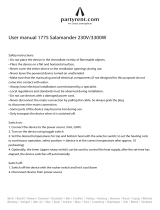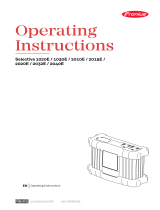2.1 General
1 To reduce the risk of electric shock – Do not expose
Mass Charger to rain, snow, spray, moisture,
excessive pollution and condensing circumstances.
To reduce risk of fire hazard, do not cover or obstruct
the ventilation openings. Do not install the Mass
Charger in a non-ventilated room, overheating may
result.
2 Use of an attachment or spare part not recommended
or sold by Mastervolt may result in a risk of fire,
electric shock, or injury to persons.
3 The Mass Charger is designed to be permanently
connected to an AC and DC electrical system.
Installation of, and work on the Mass Charger, may be
carried out only by a qualified, authorised and trained
technician or electrician, consistent with the locally
applicable standards and regulations.
4 Make sure that all wiring is properly installed and in
good electrical condition; and that wire size is large
enough for AC current rating of the Mass Charger.
Check the wiring on a regular base, at least once a
year. Do not use the Mass Charger when the wiring is
undersized or damaged.
5 Do not operate the Mass Charger if it has received a
sharp blow, been dropped, or otherwise damaged in
any way; take it to qualified personnel.
6 Except for the connection compartment (see section
Overview connection compartment3.11 on page 9),
the Mass Charger may not be opened or
disassembled. There are no serviceable parts inside
the cabinet. Take it to qualified, authorized and
trained service personnel when service or repair is
required. Incorrect reassembly may result in a risk of
electric shock or fire. Only qualified, electrician
installers are authorized to open the connection
compartment.
7 To reduce risk of electric shock, disconnect the Mass
Charger from both AC and DC electrical system
before attempting any maintenance or cleaning.
Turning off controls will not reduce this risk.
8 The Mass Charger must be provided with an
equipment-grounding conductor to the AC input
ground terminal. Grounding and all other wiring must
comply with local codes and ordinances.
9 Short circuiting or reversing polarity will lead to
serious damage to batteries, Mass Charger, wiring as
well as accessories. Fuses cannot prevent damage
caused by reversed polarity and the warranty will be
void.
10 In case of fire, you must use the fire extinguisher
which is appropriate for electrical equipment.
11 If applied in a marine application in the United States,
external connections to the Mass Charger shall
comply with the United States Coast Guard Electrical
Regulations (33CFR183, Sub part I).
2.2 Explosive gases
1 WARNING: risk of explosive gases. Working in vicinity
of a lead-acid battery is dangerous. Batteries
generate explosive gases during normal battery
operation. For this reason, it is of utmost importance
that each time before using the Mass Charger, you
read this manual and follow the instructions exactly.
2 To reduce risk of battery explosion, follow these
instructions and those published by battery
manufacturer and manufacturer of any equipment you
intend to use in vicinity of the battery. Review
cautionary marking on these products.
3 DANGER: To reduce the risk of explosion – Never
use the Mass Charger in situations where there is
danger of gas or dust explosion or an area in which
ignition-protected equipment is required.
2.3 Warnings regarding the use of batteries
1 Someone should be within range of your voice or
close enough to come to your aid when you work near
a lead-acid battery.
2 Have plenty of fresh water and soap nearby in case
battery acid contacts skin, clothing, or eyes.
3 Wear complete eye protection and clothing protection.
Avoid touching eyes while working near battery.
4 If battery acid contacts skin or clothing, wash
immediately with soap and water. If acid enters eye,
immediately flood eye with running cold water for at
least 10 minutes and get medical attention
immediately.
5 NEVER smoke or allow a spark or flame in vicinity of
a battery or engine.
6 Do not short circuit batteries, as this may result in
explosion and fire hazard! Be extra cautious to reduce
risk of dropping a metal tool onto a battery. It might





















